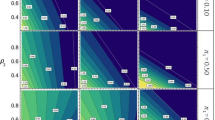Abstract
In this study, we present some of the basic ideas of population genetics. The founders of population genetics are R.A. Fisher, S. Wright, and J. B.S. Haldane. They, not only developed almost all the basic theory associated with genetics, but they also initiated multiple experiments in support of their theories. One of the first significant insights, which are a result of the Hardy–Weinberg law, is Mendelian inheritance preserves genetic variation on which the natural selection acts. We will limit to simple models formulated in terms of differential equations. Some of those differential equations are nonlinear and thus emphasize issues such as the stability of the fixed points and time scales on which those equations operate. First, we consider the classic case when selection acts on diploid locus at which wу can get arbitrary number of alleles. Then, we consider summaries that include recombination and selection at multiple loci. Also, we discuss the evolution of quantitative traits. In this case, the theory is formulated in respect of directly measurable quantities. Special cases of this theory have been successfully used for many decades in plants and animals breeding.
Similar content being viewed by others
References
Karlin, S., Some mathematical models of population genetics, Am. Math. Mon., 1972, vol. 79, no. 7 pp. 699–739.
Lange, K., Applied Probability, New York: Springer-Verlag, 2003.
Ignatieva, E.V., Podkolodnaya, O.A., Orlov, Yu.L. et al., Regulatory genomics: combined experimental and computational approaches, Russ. J. Genet., 2015, vol. 51, no. 4 pp. 334–352.
Markel, A.L., Evolutionary and genetic roots of hypertensive disease, Russ. J. Genet., 2015, vol. 51, no. 6 pp. 545–557.
Cavalli-Sforza, L.L. and Bodmer, W.F., The Genetics of Human Populations, San Francisco: Freeman, 1971.
Crow, J.F. and Kimura, M., An Introduction to Population Genetics Theory, New York: Harper and Row, 1970.
Elandt-Johnson, R.C., Probability Models and Statistical Methods in Genetics, New York: Wiley, 1971.
Hartl, D.L. and Clark, A.G., Principles of Population Genetics, Sunderland: Sinauer Assoc., 1989.
Jacquard, A., The Genetic Structure of Populations, New York: Springer-Verlag, 1974.
Nagylaki, T., Introduction to Theoretical Population Genetics, Berlin: Springer-Verlag, 1992.
Nagylaki, T., Introduction to Theoretical Population Genetics, Berlin: Springer-Verlag, 1992.
Kanzafarova, R.F., Kazantseva, A.V. and Khusnutdinova, E.K., Genetic and environmental aspects of mathematical disabilities, Russ. J. Genet., 2015, vol. 51, no. 3 pp. 223–230.
Li, C.C., First Course in Population Genetics, Pacific Grove: Boxwood Press, 1976.
Nesse, R.M., When Bad Genes Happen to Good People, Technology Review, 1995.
Bennet, J.H., On the theory of random mating, Ann. Eugen., 1952, vol. 17, no. 1 pp. 311–317.
Geiringer, H., Further remarks on linkage theory in Mendelian heredity, Ann. Math. Stat., 1945, vol. 16, no. 4 pp. 390–393.
Lange, K., A stochastic model for genetic linkage equilibrium, Theor. Pop. Biol., 1993, vol. 44, no. 2 pp. 129–148.
Efremov, V.V., Equilibrium between genetic drift and migration at various mutation rates: simulation analysis, Russ. J. Genet., 2005, vol. 41, no. 9 pp. 1055–1058.
Trifonova, E.A., Spiridonova, M.G. and Stepanov, V.A., Genetic diversity and the structure of linkage disequilibrium in the methylenetetrahydrofolate reductase locus, Russ. J. Genet., 2008, vol. 44, no. 10 pp. 1224–1232.
Zhdanova, O.L. and Frisman, E.Ya., Modelling of selection acting upon the pleioptropic locus in a population with two age classes, Russ. J. Genet., 2014, vol. 50, no. 8 pp. 879–890.
Bürger, R., Some Mathematical Models in Evolutionary Genetics, Basel: Springer-Verlag, 2011, pp. 67–89.
Akin, E., The Geometry of Population Genetics, New York: Springer-Verlag, 1979.
Akin, E., Cycling in simple genetic systems, J. Math. Biol., 1982, vol. 13, no. 3 pp. 305–324.
Hastings, A., Stable cycling in discrete-time genetic models, Proc. Natl. Acad. Sci. U.S.A., 1981, vol. 78, no. 11 pp. 7224–7225.
Hofbauer, J. and Iooss, G., A Hopf bifurcation theorem of difference equations approximating a differential equation, Monatsh. Math., 1984, vol. 98, no. 2 pp. 99–113.
Nagylaki, T., Error bounds for the fundamental and secondary theorems of natural selection, Proc. Natl. Acad. Sci. U.S.A., 1991, vol. 88, no. 6 pp. 2402–2406.
Fisher, R.A., The Genetical Theory of Natural Selection, Oxford: Clarendon Press, 1930.
Shahshahani, S., A New Mathematical Framework for the Study of Linkage and Selection, Providence: Amer. Math. Soc., 1979.
Svirezhev, Yu.M., Optimality principles in population genetics, in Studies in Theoretical Genetics, Novosibirsk: Inst. Tsitol. Genet., 1972, pp. 86–102.
Bürger, R., The Mathematical Theory of Selection, Recombination, and Mutation, Chichester: Wiley, 2000.
Burger, R., A multilocus analysis of intraspecific competition and stabilizing selection on a quantitative trait, J. Math. Biol., 2005, vol. 50, no. 4 pp. 355–396.
Schneider, K.A., A multilocus–multiallele analysis of frequency-dependent selection induced by intraspecific competition, J. Math. Biol., 2006, vol. 52, no. 4 pp. 483–523.
Schneider, K.A., Long-term evolution of polygenic traits under frequency-dependent intraspecific competition, Theor. Popul. Biol., 2007, vol. 71, no. 3 pp. 342–366.
Mackay, T.F.C., Quantitative trait loci in Drosophila, Nat. Rev. Genet., 2001 vol. 2, pp. 11–20.
Barton, N.H. and Keightley, P.D., Understanding quantitative genetic variation, Nat. Rev. Genet., 2002, vol. 3, pp. 11–21.
Lande, R., Quantitative genetic analysis of multivariate evolution applied to brain: body size allometry, Evolution, 1979, vol. 33, no. 1, part 2, pp. 402–416.
Barton, N.H. and Turelli, M., Adaptive landscapes, genetic distance and the evolution of quantitative characters, Genet. Res., 1987, vol. 49, no. 2 pp. 157–173.
Barton, N.H. and Turelli, M., Natural and sexual selection on many loci, Genetics, 1991, vol. 127, no. 1 pp. 229–255.
Turelli, M. and Barton, N.H., Dynamics of polygenic characters under selection, Theor. Pop. Biol., 1990, vol. 38, no. 1 pp. 1–57.
Bürger, R., Moments, cumulants, and polygenic dynamics, J. Math. Biol., 1991, vol. 30, no. 2 pp. 199–213.
Author information
Authors and Affiliations
Corresponding author
Additional information
The article is published in the original.
Rights and permissions
About this article
Cite this article
Traykov, M., Trenchev, I. Mathematical models in genetics. Russ J Genet 52, 985–992 (2016). https://doi.org/10.1134/S1022795416080135
Received:
Published:
Issue Date:
DOI: https://doi.org/10.1134/S1022795416080135




